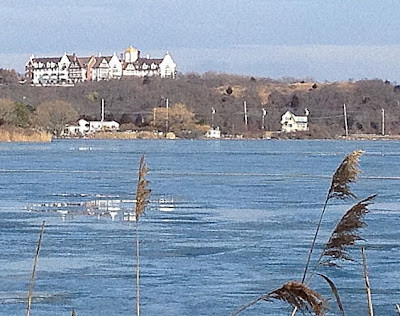The DEC keeps a close eye on goings on in the pond, which they have stocked with walleye, since 1997, as a tactic to reduce an overabundant perch population. To keep the marine environment in balance, they strictly regulate the length of the fish you can take out of the pond, as well as those caught in saltwater, as my husband will attest, having been stopped and boarded more than once by the DEC and East Hampton Marine Patrol, while fishing with our cousin, Mitch, on his family's boat, the El Sid. Last summer, the agents, armed with tape measures to make sure no fish was short of the proscribed length, happened to be young and female, a fact which led the menfolk - who had perhaps been in the sun too long - to speculate that the boarding was less about picking out short fish than picking them up.
In any case, this was the view of Fort Pond this week. To paraphrase Gershwin: Fish were not jumpin'.
 |
| Iceskaters maybe; fishermen, no. |
 |
| Whiteout |
Frozen or not, however, there's clearly no fort in Montauk. So I was wondering: How did Fort Pond gets its name? Apparently, it harkens back to 1661, when the Montauk Indians built a fortress on a hill overlooking the pond, in response to a bloody massacre that ensued when Narragansetts from across Block Island Sound attacked the Montauks during a wedding celebration. (By the same token, this would also explain Fort Pond Road, Fort Hill Cemetery, etc.)
Today, it is the Montauk Manor that holds the high ground. And, presumably, it's doing a good job of protecting the tourists, since there hasn't been an Indian attack in years.
 |
| The Montauk Manor: Holding the high ground for the tourists |
 |
| Good day for a wedding; no Narragansetts in sight |
No comments:
Post a Comment
Thanks for reading!